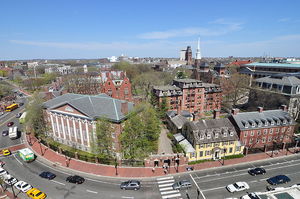Victor Vasarely was a very important artist. He is a French Hungarian who was not only a great optical artist, but he is also known as the father of optical art. His pieces of art set the ground for later optical artists and are known as some of the best.
He was born on April 9, 1809 in Pecs, Hungary. After a while he moved to Budapest where he went to college at Budapest University and studied medicine (www.wikipedia.org). In 1927 he decided that he did not like the field of medicine so he decided to learn traditional academic painting. He then enrolled in Sandor Bortnyik’s Muhley which was a small workshop where he learned about art (www.wikipedia.org). In this workshop Vasarely focused on graphic art and typographic art.
Soon he was recognized as a great drawer and in 1929 he created his famous paintings called the blue study and Green study. Soon after this he married a fellow student named Claire Spinner and together they had 2 sons. When he got married, he got a job at a ball bearing company where he designed posters for the advertising department of the company.
Very soon after marrying and finding a job he left Hungary and move to Paris in 1930 (www.wikipedia.org). While there, he worked as a graphic artist and consultant for advertising agencies. He also began to think about opening a workshop like the one he worked at earlier in his life. He even had teaching material for the workshop, but instead he opened an art studio in Arcueil (www.wikipedia.org). Soon after this he settled down, for what seems like the first time in his life, in the town of Annet-Sur-Marne. During the next 30 years that he was there he developed his geometric abstract art.
Vasarely did many types of art in his early works he experimented with textures, perspective, light, and shadow. These experiments led him to draw zebras and many other things. His next phase in art was using cubistic, futuristic, expressionistic, symbolistic, and surrealistic styles of painting. These styles did not interest him and in the end he said that he was on the wrong track.
After going on the wrong track he came back with a success. He developed kinematic images which create dynamic, moving impressions, by using acrylic glass panes. Another thing that he did was find a way to make frames become a single pane by transposing photographs into 2 colors, which back then was black and white. He also used this type of art to help in architecture. Proof is that he is the co designer of the ceramic wall picture at the University of Caracas.
The next project he did was patenting his method called “unités plastiques” (www.wikipedia.org). This was where different geometric shapes are cut out of colored paper and are then rearranged. This was the beginning of a new type of art called serial art which he created when he started using his plastic alphabet. After he put the final touches on his new type of art he presented it to the public under a false name, so that people wouldn’t know that it was his if they didn’t like it.
Finally in 1965 he started on his last project. He began to created lots of transformations and used variations of color which in the end created optical (http://www.albrightknox.org/ArtStart/Vasarely.html). This art used spherical swelling grids to do an optical illusion that a sphere is coming out of the page.
After he was done painting he began to open his first dedication museum. In this museum there are about 500 pieces of art. His second museum not only has his work in it, but the building was also designed by him. Although he may have many museums with his work he has donated many of his works to other museums. At last on March 15, 1997 He died in Paris (http://arthistory.about.com/cs/namesvv/p/vasarely.htm). This put an end to a very great artist who contributed a lot to the art community.
Vasarely was a great artist who did a lot for the art community. He is the father to many styles of art, he created many good paintings, and he influenced art in such a way that if he hadn’t done all the things he did, then art would have never been the same.



